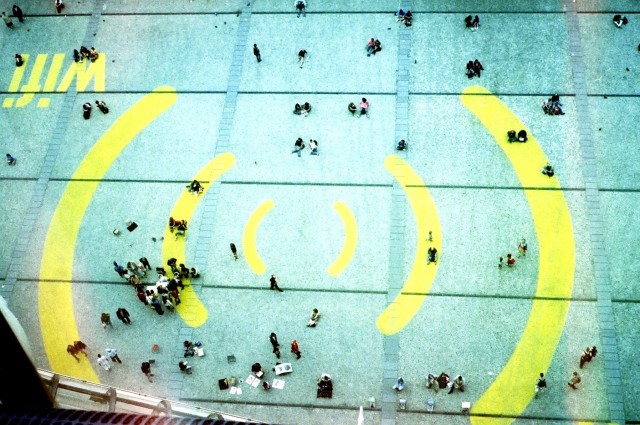
Frank Swain, a 32 year-old science writer from London, was first diagnosed with early onset hearing loss when he was in his 20s. In 2012, he was fitted with hearing aids. And as soon as he got them, he began contemplating how he might hack them so he could hear more of the world going on around him. Specifically, he wanted to be able to hear something that fills our modern landscape, but is undetectable to our ears.
In short, Swain wanted to be able to hear Wi-Fi signals.

Two years later, after receiving a grant from UK innovation charity Nesta - the UK innovation charity - Swain and sound artist Daniel Jones came together to produce Phantom Terrains, a new tool that makes Wi-Fi signals audible. One might think this an odd choice, until they consider just how much electromagnetic signals permeate our modern environment.
As Swain wrote in a recent piece for New Scientist:
"Our modern world is suffused with data. Since radio towers began climbing over towns and cities in the early 20th century, the air has grown thick with wireless communication, the platform on which radio, television, cellphones, satellite broadcasts, Wi-Fi, GPS, remote controls and hundreds of other technologies rely. And yet, despite wireless communication becoming a ubiquitous presence in modern life, the underlying infrastructure has remained largely invisible."

Every day, people use wireless signals to make phonecalls, access navigational data, check their emails, listen to the radio, and surf the web. And given its current rate of growth, it is believed to be just a matter of time before all the devices, routers, sensors and signals usher in the "Internet of Things" - an age where the world is surrounded by a digital "second skin" that overlays the physical world and is inseperable from our lives.
And yet, the infrastructure for all this remains intangible to us. Hence why Swain and Jones invented Phatom Terrains, so that people could tune into these fields. The software can be run on a hacked iPhone, which uses the inbuilt Wi-Fi sensor to pick up important details about nearby fields - including the router name, signal strength, encryption, and distance.
So long as he has his iPhone in his pocket, Swain gets a kind of aural map blended in with the normal output of the hearing aids. Distant signals are interpreted as background clicks that vary with proximity (like a Geiger counter), while closer and more powerful signals sing out their own network ID information in a looped melody.
"On a busy street, we may see over a hundred independent wireless access points within signal range," says Jones. The strength of the signal, direction, name and security level on these are translated into an audio stream made up of a foreground and background layer.
As Swain said of the experience: "Recreating hearing is an incredibly difficult task. Unlike glasses, which simply bring the world into focus, digital hearing aids strive to recreate the soundscape, amplifying useful sound and suppressing noise. As this changes by the second, sorting one from the other requires a lot of programming."

To test their concept, Swain walked through South London, collecting tons of data as he went. He then had the information visualized by London-based designer Stefanie Posavec (shown above). The resulting map tells us where routers were, their bandwith and encryption level. From this data, Swain was able to see that residential areas are dominated by low-security routers, whereas commercial districts were filled with highly encrypted routers.
Because the system allows Swain to actually hear technical distinctions between Wi-Fi networks, and locate their source, Phantom Terrains represents a new sort of notional cartography. For instance, Swain has found that residential areas tend to be full of low-security routers, where commercial districts have highly encrypted routers broadcasting with much higher bandwidth.
And as Jones explained, this sort of technology can be used to extract meaningful data from the surrounding landscape: “Just as the architecture of nearby buildings gives insight to their origin and purpose, we can begin to understand the social world by examining the network landscape," he said.
Mapping digital fields isn't an entirely new idea. Timo Arnall's Light Painting Wi-Fi, for example, employed a rod of LEDs that lit up when they were exposed to digital signals. Carrying this rod through the city at night, and captured in long exposure photographs, the topographies of wireless networks appeared as a ghostly blue ribbon that waxed and waned to the strength of nearby signals, revealing the digital landscape.

In addition, artists Nickolay Lamm, a blogger for MyDeals.com, recently created a series of visualizations that showed the size, shape, and color of wi-fi signals. As you can see from the picture above (which shows the Capitol Building in Washington, D.C., drenched in microwave radiation), his work shows what the landscape would look if the interent were visible to the human eye.
As internet technology, wireless communications and connected devices become more common, the ability to sense the strength, intensity, and what these signals can tell us about our environment will likely become far more sought after. One can imagine without much effort "Wi-Fi mapping" becoming a part of urban or community planning, not to mention sociological or environmental studies.
To get a sense of what "hearing" Wi-Fi is like, check out the recording Swain made of his South London walk on soundcloud.
Sources:
- phantomterrains.com/
- www.frankswain.com/
- www.iflscience.com/technology/man-can-hear-wi-fi-and-what-it-sounds
- news.discovery.com/tech/gear-and-gadgets/man-hears-wi-fi-via-hacked-hearing-aids-141114.htm
- www.independent.co.uk/life-style/gadgets-and-tech/one-man-hears-wifi-wherever-he-walks-9858488.html
- www.newscientist.com/article/mg22429952.300-the-man-who-can-hear-wifi-wherever-he-walks.html#.VG5UcskiCtp
- soundcloud.com/ideoforms/phantom-terrains-broadcasting-house
- motherboard.vice.com/blog/this-is-what-wi-fi-would-look-like-if-we-could-see-it








